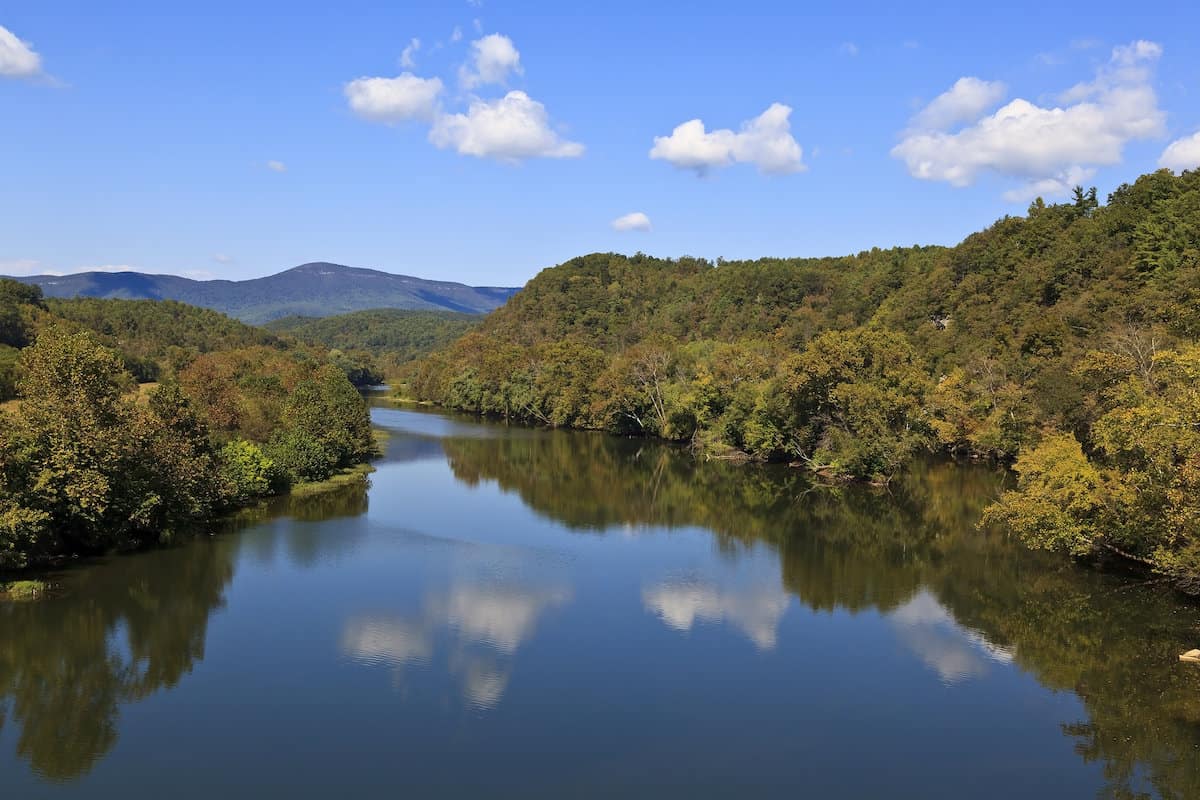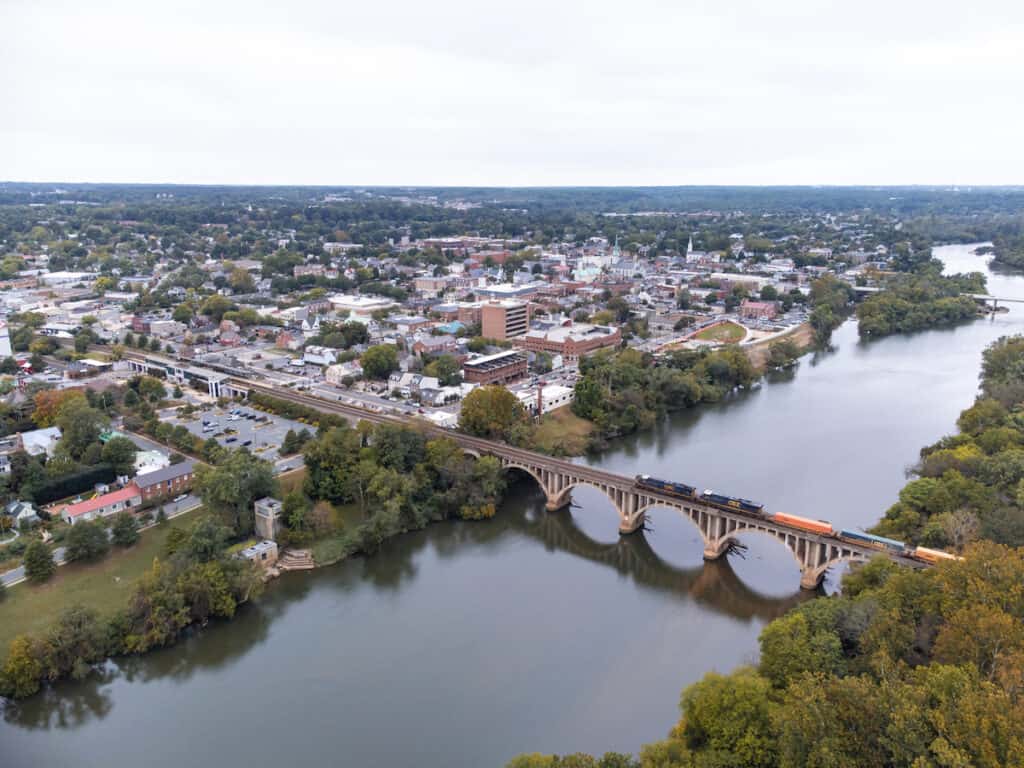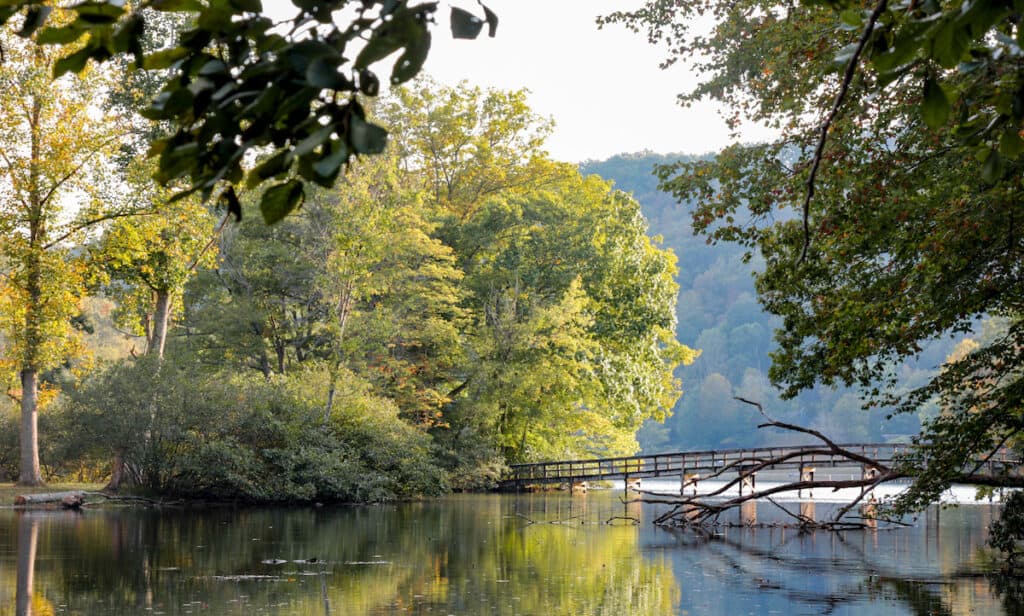Catfish have a devoted following everywhere they swim. Whether you’re a trophy hunter in search of 100-pound river monsters or simply enjoy catfish filets dusted in cornmeal and deep fried, it could easily be said that Virginia is for catfish lovers.
Some of the best catfish angling opportunities in the Mid-Atlantic states can be found in Virginia’s rivers and lakes. Native channel catfish are prolific all across the state, and flathead catfish, too, have expanded well beyond their original range.
In recent decades, Virginia has also become known as one of the best states for catching enormous blue catfish. First introduced here in the 1970s, blues have not only survived, but thrived.
Blue cats are especially prevalent in the tidal tributaries that feed the Chesapeake Bay, where they sometimes reach sizes over 100 pounds. Catfish anglers in Virginia would be well advised to use sturdy tackle.
Best Catfish Rivers in Virginia
James River
There are a lot of great catfish rivers in Virginia, but perhaps none more legendary than the James. This 348-mile river flows from the Appalachian Mountains to the Chesapeake Bay and provides some of the best catfish angling in the Eastern U.S.
The tidal portion of the James River is especially noteworthy. This section is where giant blue catfish have come to thrive, and anglers have caught some blues weighing 100-plus pounds here. Fish like that are rare, but blue cats weighing 30 to 50 pounds are not out of the ordinary.
Blue catfish inhabit areas throughout the lower James River—they were first stocked here in the 1970s and have since proliferated—but the right combination of timing and location will put the odds in your favor.
The best stretch of the James River for big blues is from roughly Sturgeon Point upriver to Dutch Gap (though plenty of these fish are caught as far down as Hog Island and as far up as Richmond). Look for deep holes, preferably with some structure.
The best structure for blue catfish tends to be of the man-made variety, like remnants of old piers, sunken barges, and bridge pilings near the channel drop-off.
Cut baits, including gizzard shad and eels, work best. Fish right on the bottom with cut bait on a 8/0 circle hook.
The best bite is at night during the summer, but anglers still catch many blue catfish during daylight hours at other times of the year.
Tides are essential in the lower James River, and most catfish bite during an incoming or outgoing tide. Moving water is key.
Several parks and landings provide bank fishing and boat access on the tidal James River. Old City Point Waterfront Park is an excellent spot, and Deep Bottom Park has a popular fishing pier and boat ramp.
Although blue catfish have been getting a lot of attention in recent years, the James River also supports abundant channel catfish throughout most of its length. Flathead catfish are common in some areas as well.
The boulder-strewn section right around the fall line in Richmond is a great area for flatheads, which hide among the thick, rocky cover waiting to ambush prey. A live sunfish on a basic sinker, leader and hook setup known as a fish finder rig is the ideal presentation.
There’s also some excellent flathead water farther up the James River from Bremo Bluff upriver to Lynchburg. This section abounds with deep, rocky pools, and is accessible via the New Canton Boat Ramp.
Speaking of big fish, the tidal section of the James River also is among the best places to catch striped bass in Virginia.
More: Complete Guide to James River Fishing
Rappahannock River
Flowing southeast across 195 miles of Eastern Virginia, the Rappahannock is part of the Chesapeake Bay watershed, and like many rivers that feed the bay, parts of it are strongly influenced by the tides.
Catfish angling opportunities abound throughout the Rappahannock River, but the river changes quite a bit from its trickling headwaters on the Blue Ridge to its broad lower reaches. The city of Fredericksburg is generally thought of as the dividing line.
Below Fredericksburg, the Rappahannock is a tidal river, with incoming and outgoing tides overpowering the river’s flow. Blue catfish are common in the tidal portion of the Rappahannock, and blues over 50 pounds are possible.
Above Fredericksburg, the river tumbles between rocky banks, forming a series of riffles and deep pools that are dominated by feisty channel catfish and smallmouth bass.
The upper Rappahannock may be the best channel cat river in Virginia.
Kelly’s Ford Landing, about 25 river miles above Fredericksburg, is a popular put-in for float trips and a great place to start exploring this section of the Rappahannock. From here to the next take-out site at Motts landing, catfish inhabit practically every pool.
Many weigh over 10 pounds, including a state record channel cat of 31.5 pounds, but 2- to 3-pound fish are much more common.
Nightcrawlers, chicken livers, cut bait, and a variety of catfish doughs are effective.
Some of the best fishing is during summer nights, but channel cats often bite during the day if there’s some cloud cover.
For blue cats, the best bet is between Port Royal and Tappahannock. Both towns offer parks with boat ramps and bank fishing, and the former also has a popular fishing pier.
Pamunkey & Mattaponi Rivers
A pair of rivers that merge in Southeastern Virginia to form the York River, the Pamunkey and Mattaponi rivers are quietly building a reputation as trophy blue cat waters that may one day rival the James.
Water from these rivers ultimately reaches the Chesapeake via the York River. The York itself is a broad, salty estuary where anglers might sometimes catch blue catfish, but the two smaller rivers that join to form it provide better opportunities, particularly in their lower tidal portions.
Both rivers produce numerous blue catfish that weigh 20 to 30 pounds, and fish up to 80 pounds are possible.
As in other tidal rivers, the best time to target blue cats is during a rising or falling tide, particularly around structure like bridges, piers and logs in or near deep water.
You’ll find a public launch ramp on the Pamunkey River at White’s Landing. Another private ramp with a launch fee is near Putney’s Mill.
West Point offers excellent launch facilities and a public fishing pier on the Mattaponi River. This spot is less than a mile from the convergence of the two rivers, making it a convenient launch site for both.
Highway 360 crosses both the Pamunkey and Mattaponi rivers, and in both cases, this route marks roughly the uppermost area where you can reliably catch blue catfish. Channel catfish are also available farther upriver.
New River
The New River is a beautiful waterway that flows northward through parts of North Carolina, Virginia and West Virginia.
Best known for its rugged scenery and for being one of America’s great smallmouth bass rivers, the New River also offers ample opportunities to hook some hard-fighting catfish.
Channel catfish are common throughout the Virginia section of the New River, which includes long, flat runs, deep pools, and occasional whitewater sections.
Some surprisingly big flatheads lurk in this river’s pools as well.
Summer is a great season to fish for catfish on the New when the river is generally low enough to wade, and most sections are navigable by canoe. The Virginia DWR provides some excellent info on float trips here.
Cast live bluegill or other baitfish around downed trees and undercut banks for flatheads. Bridge pilings are also good structures to target for both channel cats and flatheads. Upstream and downstream ends of islands are often productive too.
Some of the best areas for catfish are in Montgomery County, including just below the Claytor Dam, below the Pepper’s Ferry/Route 114 bridge, and in the Belspring area. Farther upriver, there are also some great holes from Foster’s Falls to Allisonia.
Dan River
One of Southern Virginia’s best catfish rivers, the Dan River originates near Meadows of Dan, just off the Blue Ridge Parkway. It’s managed as a trout stream in its upper reaches, but catfish and other warm water species increasingly dominate sections farther downriver.
The Dan River zig-zags across the North Carolina state line multiple times before emptying into Buggs Island Lake. Catfish are common throughout much of this 214-mile river, but the best fishing is from Danville downstream to the lake.
Flatheads are the target species for many anglers, who drift live sunfish or cut bait through deep pools and around thick cover like rocks and laydowns. Some of the best spots are creek mouths and deep holes along river bends.
Channel catfish are also common, and blue catfish become increasingly available closer to Buggs Island Lake. The lower Dan River is well suited to float trips while also being navigable by motorboats.
The Milton Boating Access site on Route 62 is a great place to start. Located right on the state line where the river enters Virginia for the final time, this site is open to anglers from both states. There are some good access sites between South Boston and Riverdale as well.
The Dan River braids out into multiple channels as the Hyco River and Aarons Creek join it. This area offers excellent catfish angling, with abundant cover such as brush and timber.
Best Catfish Lakes in Virginia
Buggs Island Lake
Known to many as Kerr Lake or Kerr Reservoir, Buggs Island Lake is a vast impoundment of the Roanoke River that sprawls across the border between Virginia and North Carolina. It has gained a reputation in recent years as one of America’s best catfish lakes.
That reputation rests on the reservoir’s increasingly gargantuan blue cats, which include the current Virginia state record and world record blue catfish, which was caught in 2011 and tipped the scales at 143 pounds.
Buggs Island Lake spans 48,900 acres, the majority of which is on the Virginia side of the state line. Catfish are all over the lake, but the upper end of the reservoir, from the Clarksville area up to the confluence of the Dan and Staunton Rivers, is the best place to target big blues.
The fishing for blue cats is pretty good here year-round, with the possible exception of June when they’re spawning in the backs of the creeks. But July through August are perhaps the best months of all.
Hungry post-spawn blues prowl the upper reservoir throughout mid-to-late summer, dining on gizzard shad and other baitfish. The best places to find them are creek and river mouths, points, and especially humps along the river channel.
Humps alongside the channel are magnets for baitfish and for the big blue cats that feed on them. There are some outstanding areas around the mouth of Bluestone Creek.
Fish cut bait on or near the bottom at 15- to 35-foot depths.
The catfish rig known as a Santee Rig is very popular here and involves pegging a small float between the hook and sinker to keep the bait slightly elevated.
Cut shad are perfect bait, and some anglers use the “throw-away” parts of crappies that have been cleaned and fileted. (Buggs Island is also among the commonwealth’s best crappie lakes, so procuring panfish scraps shouldn’t be a problem.)
Kerr Lake also has a decent population of flathead catfish. Unlike blue cats, which simply grab a bait and swim off, flatheads often make multiple passes at a bait before committing. So if your rod tip starts to jiggle, give the fish a chance to really grab on before setting the hook.
You’ll find no shortage of access at Buggs Island Lake, including several marinas and parks with boat ramps toward the upper end of the reservoir. Staunton River State Park offers launch facilities, bank fishing and a campground.
Anglers catch plenty of big catfish in deep water, but you don’t need a boat to be successful.
Buggs Island Lake is usually drawn down significantly during the cooler months, which opens up almost the entire lakeshore to bank fishing.
More: Complete Guide to Fishing at Buggs Island Lake (Kerr Lake)
Lake Chesdin
Created in 1968 with the construction of the George F. Brasfield Dam on the Appomattox River, Lake Chesdin is a long, narrow reservoir of 3,100 acres in south-central Virginia.
In addition to being an outstanding bass and crappie lake, and even one of Virginia’s better walleye fishing lakes, the reservoir also offers an abundance of catfish.
Channel catfish are the dominant species by a wide margin. A state record channel cat weighing 32 pounds was caught here in 1980, but today the lake is known for producing eating-size catfish that weigh about 2 pounds, along with plenty in the 5- to 7-pound range.
Lake Chesdin also offers flatheads that average 8 to 12 pounds, and recent surveys by the Virginia DWR suggest that flathead numbers are increasing.
Anglers may occasionally tussle with a much bigger blue cat, though they’re not very common.
Channel catfish in Lake Chesdin are fairly evenly distributed throughout the lake and are seldom hard to find. Fishing standard baits like chicken livers and nightcrawlers just off the bottom usually does the trick.
The upper third of the reservoir, which has a more riverine character and is often turbid, provides some of the best catfish action, especially in spring. Try fishing around steep banks, drop-offs to the river channel, and mouths of tributaries.
Anglers catch quite a few catfish in tributaries like Whippernock Creek, which has good bank access along the Sutherland Road bridge.
You can launch a boat at the nearby Whippernock Marina and Campground.
Flannagan Reservoir
1,143-acre John W. Flannagan Reservoir is an often-underrated catfish lake in the Cumberland Mountains of Southwestern Virginia, a stone’s throw from the Kentucky state line. The lake supports ample populations of flathead and channel catfish.
Flannagan Reservoir’s resident cats are known more for numbers than size. This is a great place to spend an evening catching scrappy 1- to 3-pound channel cats, along with some flatheads that top 10 pounds.
The lake is exceptionally clear during summer and fall, when fishing at dusk or after dark is the best option. Daytime angling is best in spring, when spring runoff stains the lake, especially at the upper end and in the various smaller creeks that feed it.
Flannagan Reservoir is also drawn down significantly from November to April every year, thus allowing expanded bank fishing access during these seasons.
You will find good bank access just off the Lake Road Bridge and at Mountain View Marina.
There are five public launch ramps on Flannagan Reservoir. Of these, the Cranesnest and Spillway are free of charge, while the others require a modest launch fee. Only the Junction Ramp is usable when the lake is at its lower winter pool.
Hungry Mother Lake
Hungry Mother Lake is a bit of a sleeper catfish lake tucked away between the Appalachian ridges and valleys of Southwestern Virginia.
A fairly small reservoir of 108 acres on Hungry Mother Creek, it is stocked every year with channel cats by the Virginia DWR.
Channel catfish have become quite abundant. Some reach impressive sizes, though fish weighing a pound or two are most common.
Anglers catch catfish all year and at all times of day at Hungry Mother Lake, but spring and summer are the best seasons.
The most popular tactic is fishing with chicken livers and nightcrawlers after dark. It’s common to see the lakeshore dotted with lanterns on summer nights.
In addition to increasing stocking size to catfish that average about 10 inches, which has helped more fish avoid predation and survive to adulthood, the DWR has placed spawning boxes throughout the lake to aid in natural reproduction.
Access to Hungry Mother Lake is available through Hungry Mother State Park, one of Virginia’s oldest state parks.
Cabins and camping are available in the park, and boat access is limited to electric trolling motors and human-powered craft.
Catch More Catfish
What are the best baits, the top hooks, the most effective tactics to catch these fish? Read our simple guide to catfish fishing techniques and tips.



